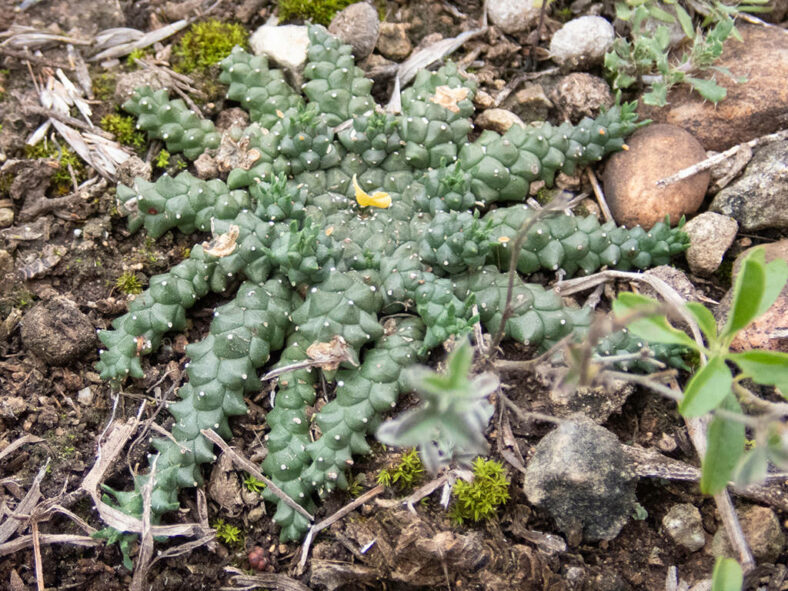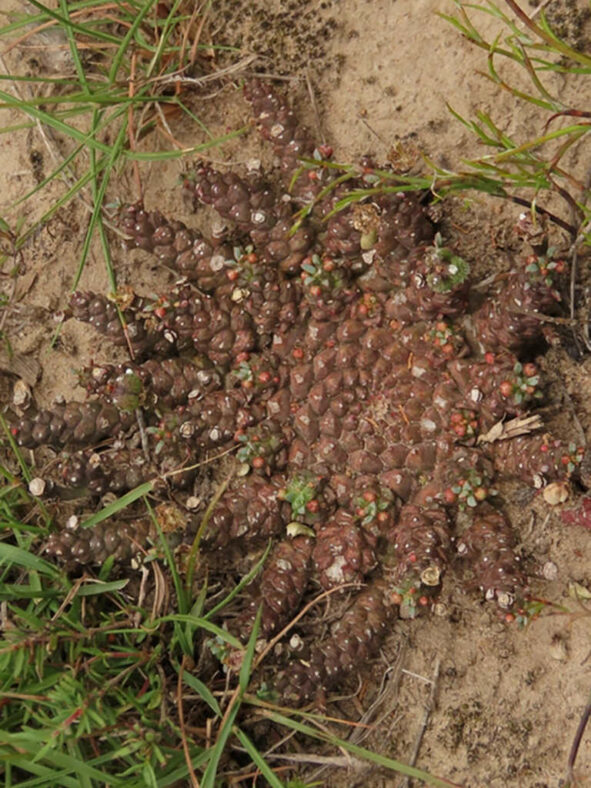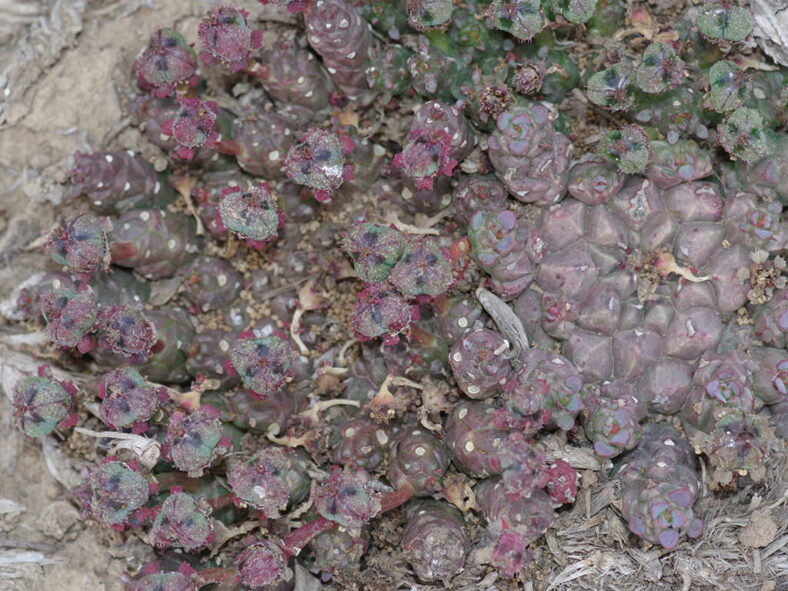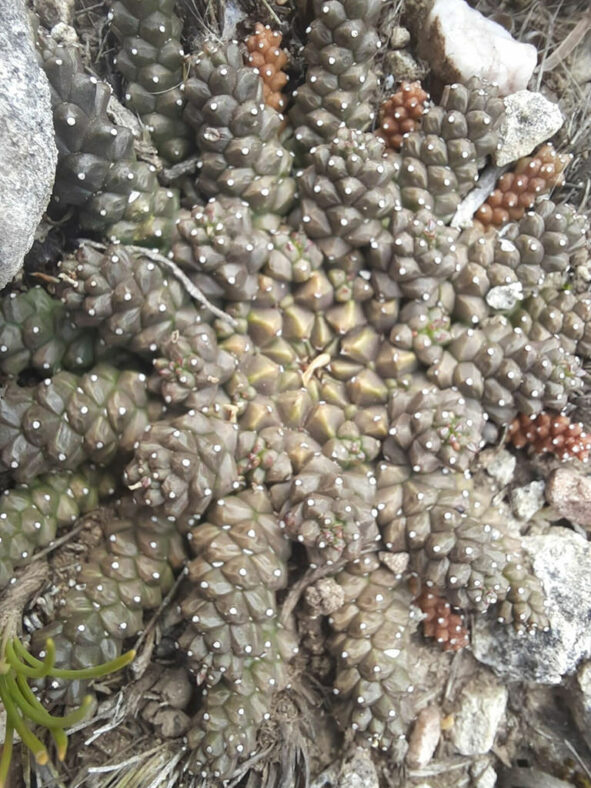Euphorbia gorgonis is a medusoid species first described by Alwin Berger in 1910. It is closely related to and sometimes treated as a synonym of Euphorbia procumbens.
Scientific Name
Euphorbia gorgonis A.Berger
Common Name(s)
Gorgon's Head
Scientific Classification
Family: Euphorbiaceae
Subfamily: Euphorbioideae
Tribe: Euphorbieae
Subtribe: Euphorbiinae
Genus: Euphorbia
Etymology
The specific epithet "gorgonis" (pronounced "gor-GOH-nis") refers to the resemblance of this species to the Gorgon's head. Gorgon is another name for Medusa, one of the three monstrous sisters in Greek mythology.
Origin
Euphorbia gorgonis is native to South Africa. It occurs on hills between the Sundays River and Zwartkops River in the Eastern Cape province.
Description
Euphorbia gorgonis is a dwarf succulent with a crown of short, radiating branches arranged in 3 to 5 series around a branchless central area. The main stem is spherical or inverted cone-shaped and can measure up to 4 inches (10 cm) in diameter, while the central area is flat or depressed and can reach up to 2 inches (5 cm). The branches are green or tinged with purple. They are cylindrical or, when young, spherical and can grow up to 1 inch (2.5 cm) long and 0.4 inches (1 cm) in diameter, but under cultivation, they can reach up to 2 inches (5 cm) in length. Both the central area and branches are covered with conical tubercles. The leaves are rudimentary, only present in young growth, and soon deciduous.
From mid-spring to mid-summer, Euphorbia gorgonis produces cyathia (false flowers) on peduncles that can grow up to 0.4 inches (1 cm) long. The cyathia have a cup-shaped involucre with a ring of 5 dark purple-brown glands and yellow actual flowers in the center. The peduncles are solitary and appear in the axils of the tubercles. The fruits are green, slightly 3-grooved capsules with blackish-grey seeds.

How to Grow and Care for Euphorbia gorgonis
Light: Euphorbia gorgonise needs plenty of sunlight for optimal growth. Place it near a sunny window or move it to your balcony or garden during the warmer months, gradually increasing sun exposure to avoid sunburn.
Soil: Use a well-draining soil, either a commercial potting mix formulated for succulents or create your own well-draining soil.
Temperature: While high summer temperatures are not a problem, low winter temperatures can damage or kill your plant. Euphorbia gorgonis grows best in USDA Plant Hardiness Zones 10a to 11b, with average minimum winter temperatures ranging from 30 to 50 °F (-1.1 to 10 °C).
Watering: From spring to fall, water the plant when the soil's top inch (2.5 cm) feels dry. Reduce watering in winter and give it just enough water to prevent wilting. In the warm season, evening is the best time of the day for watering.
Fertilizing: To ensure the potted plant receives sufficient nutrients, apply a balanced fertilizer in a 10-10-10 NPK formulation, diluted to 1/4 strength weekly during the growing season.
Repotting: Although your Euphorbia gorgonis does not need to be repotted often, it will benefit from repotting when it outgrows its pot. Repotting is best done in early spring at the beginning of the growing season. Wear gloves, protective clothing, and appropriate eye protection when handling this plant.
Propagation: The easiest and quickest way to propagate this plant is by stem cuttings. However, it is essential to note that the new plant may not resemble the mother plant. While it can be grown from seeds, germination can be challenging. It is best to take cuttings only during the growing season, while spring is the ideal time to sow seeds.
Learn more at How to Grow and Care for Euphorbia.
Toxicity of Euphorbia gorgonis
Euphorbia gorgonis produces a poisonous white milky sap that may cause burns or irritation if it comes into contact with the skin or eyes. Therefore, keeping this plant away from children and pets is best.
Links
- Back to genus Euphorbia
- Succupedia: Browse succulents by Scientific Name, Common Name, Genus, Family, USDA Hardiness Zone, Origin, or cacti by Genus
Photo Gallery
Click on a photo to see a larger version.


